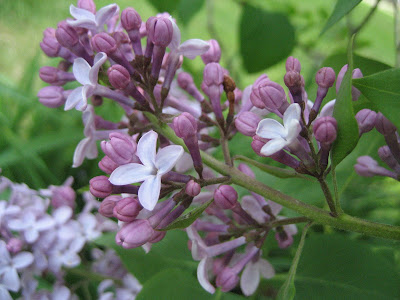
Syringa vulgaris is the state flower of New Hampshire, because it "is symbolic of that hardy character of the men and women of the Granite State" (New Hampshire Revised Statute Annotated (RSA) 3:5).
In my little part of the world, you may count on lilacs on Memorial Day, or as it is now known, Memorial Day Weekend. Whether the winter is long or short, whether the spring is wet or dry, cool or warm, the lilacs are in bloom. It is a miracle of life to me.

When we first moved here 26 years ago, there was only one lilac bush. We brought with us my mother's dark purple lilacs and our neighbor's light purple ones. We've bought some plants over the years and divided others until we have lilacs all over the place. The one original has since become a part of the south pasture, and we must put mesh fencing all around the bottom so the animals don't eat it. Lilacs seem to be a delicacy, particularly to goats.

Henry Mitchell says,
South of Washington, Richmond, Birmingham, and Memphis, lilacs are chancy indeed, but north of those cities, all the way to the North Pole, I suppose, they are a joy of full-blown spring. They make up, a little, for the lack of crape myrtles and oleanders in arctic-type places.
Gladys Taber writes,
Faith is a strange and wondrous thing. All winter we see the lilacs leaning against the blizzards, grey, lifeless. Nothing could look more dead than a lilac bush in January. It is only a bunch of sticks. The only thing alive about it is the chickadee swinging on a doughnut hung on a branch. Quite casually the miracle begins. There is never a moment when we can say, now the buds have begun to swell. As love ripens in a good marriage, the lilacs turn the tight glassy buds into small spikes,and then into visible purple. And then in May, a flowering time comes. The air is filled with deep, rich fragrance - and who can describe the odor of lilacs? It is a romantic scent, heavier than roses, but never cloying.
Lilacs, I think, are the theme song of New England, even more than apple blossoms or the ramblers which will follow. Yet they are not peculiar to New England, for I remember in northern Wisconsin in Door County, we used to drive out to gather great bouquets of them growing around deserted cabins. Or where a house once stood, around the blackened chimney, the lilacs gave a sweet immortality to the home that had gone.


What a lovely post. Here in Indiana, the common lilacs bloom in late April, followed by Miss Kim lilacs a few weeks later. I'd love to have some still blooming now!
ReplyDeleteSo very lovely. Thanks for sharing them!
ReplyDeleteThanks, Carol and Kay. We have the Miss Kim too, which will bloom later. If I could freeze time, it would be today. Low 70s, breezy, sunny, and all those lilacs everywhere I look.
ReplyDeleteHow lovely! I've seen some lilacs blooming here in Western Washington, but they are always overshadowed by the showmanship of the rhododendrons. I miss the simple beauty of the lilacs I grew up with!
ReplyDeleteWhile I consider myself very familiar with the work of Gladys Taber, I never heard her mention beautiful Door County, which is not to far from my home. How exciting to know that she set foot there! Thank you so much for sharing the passage.
ReplyDeleteRobin, I do see some rhododendrons in yards, but I'm quite sure we are too cold for them. They are pretty spectacular. But I know what you mean. Lilacs do have a "homey" quality to them.
ReplyDeleteAnonymous (sorry to address you like that), Gladys Taber was born in Appleton, Wisconsin, but you probably already know that. :<) It is a state I've often wanted to visit.